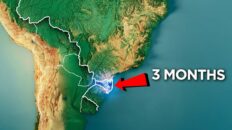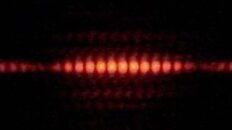Rings around planetary bodies is surprisingly common. So why doesn’t the Earth have rings? Today we take a look at how rings form, what kind of rings Earth could have, how they would have shaped humanity, and why many scientists believe once upon a time, we did.
TRANSCRIPT:
Astronomers have known about planetary rings since 1610. Sort of. That was when Galileo Galilei, the telescope guy, first described the planet Saturn as “triple bodied”.
He meant he could see three objects, three stars to his way of thinking, when he looked at Saturn. The central star was bigger that its two companions. The three floated so together, they almost touch.
Two years later, Galileo got a shock. When he looked at Saturn in 1612, the companion stars we gone! We know now he was seeing a ring-plane crossing, an event that happens about once every fifteen years.
During a ring-plane crossing, the rings of Saturn appear edge-on as viewed from Earth. They’re basically invisible, unless you have a much better telescope than Galileo had. It wasn’t until 13 years after Galileo’s death that someone solved the mystery of the lost stars.
In 1655, Dutch astronomer Christiaan Huygens got a look at Saturn and said it was surrounded a “thin, flat ring.” He would go on to discover Saturn’s largest moon, Titan, and describe how our view of the ring changes His 1659 book Systema Saturnium explained ring-plane crossing for the first time.
200 years later, Chapelain was proved right. In 1856, Scottish physicist James Maxwell proves with math that a solid ring would be unstable. Oh, and somewhere Chapelain’s and Maxwell’s time, some guy named Cassini discovered four more moons around Saturn.
In 2005, the Cassini spacecraft dropped the Huygens probe on the surface of Titan. I’d like to tell you it carried a book of Chapelain’s poetry. That probably didn’t happen.
Point is, we’ve been fascinated with the rings ever since we first noticed them. Just the idea of tiny satellites moving in such a tight orbit they appear solid gets our nerd senses tingle. We get even more tingly when we learn there are billions of satellites, mostly made of ice, that can be small as a grain of sand or huge as a mountain.
And this just in: other planets have rings. The rings around Jupiter, Uranus and Neptune are far fainter than Saturn’s main rings. They were all discovered in the past fifty years.
Ring systems also exist around the minor planets Chariklo and Haumea. Those are both in our solar system. This past February, 2023, rings were confirmed around Quaoar, a dwarf dwarf planet in the Kuiper belt.
The Quaoar discovery calls into question some theories about how rings behave. It was thought rings could only exist close to a planetary body, where tidal forces stop them from clumping up. Quaoar’s rings are twice as far out as they should be.
So there’s plenty more to learn about rings. It sure would be helpful if we had one close to home we could visit. Sadly, we don’t…but we used to!
Yep. Turns out Earth did have rings. At least according to some ideas about Moon formation.
Proponents of the Giant Impact Hypothesis say a collision between Earth and proto-planet Theia created the Moon. Proponents of a different hypothesis say it took multiple impacts with rocky objects. But proponents of both hypothesis agree, rings pre-date the Moon.
They formed from debris that got launched into orbit. Tidal forces eventually caused the debris to coalesce and get flung off. But while that was happening, the rings persisted for centuries.
They’re obviously gone, now. But the fact they probably were there got me thinking. What would life on Earth be like if our rings were still there?
The rest of this video will be pure speculation. But it’ll be fun. I hope you stick around.
To get started on our answer, let’s talk composition. The icy rings of Saturn would melt if they were around Earth. It’s simply too hot so close to the Sun.
Ancient Earth’s rings were rock and dust. Modern Earth rings would be similar. I mean, we could have a ring of gas, but it wouldn’t be visible, which defeats the point of the exercise.
What would rings of rock look like? They wouldn’t be shiny as Saturn’s rings. They wouldn’t reflect as much light.
But they wouldn’t have to, because they’d be closer. In a LiveScience article I’ll link below, author Charles Q. Choi quotes Columbia University director of astrobiology Caleb Scharf. Scharf mentions the amount of the light the moon reflects, twelve percent, and speculates about a ring that reflects only 10% of sunlight.
“About 1,300 watts of sunlight per square meter hits the top of Earth’s atmosphere,” says Scharf. So 10% reflection means each square meter of ring-stuff would give as much light as “a 130-watt light bulb.”
Why did he mention “the top of Earth’s atmosphere”? Because that’s how close a ring could get before atmospheric drag turned its rocks into meteors. This would happen at around 1000 kilometers.
That’s good news for man-made satellites. Most, including the International Space Station, operate below the 1000km mark. But some important satellites, like those used for GPS, do orbit farther out.
That brings up another question. How far could the rings extend? In theory, they could stretch to the Roche Limit.
Satellites inside that boundary will remain debris. Satellites outside will clump into small moons. Calculating Roche Limit is complicated, but for the sake of argument, I’ll use the Roche Limit for an average comet passing near Earth.
A rigid comet will shatter at 2.8 Earth radii. That’s about 17,880 km. So a rocky ring system could fill Earth’s orbit from 1000 to 17,800 km.
The rings would most likely be anchored at the equator, where Earth’s rotational speed is higher. Launching from the equator gives satellites extra oomph to go higher. Still, plenty of launches have been done at higher other latitudes.
So, what would a ring system look like in the sky? If you were looking at our rings, what you saw would vary based on your distance from the equator. In Quito, Ecuador or Nairobi, Kenya, you would see a straight line arcing from the eastern to western horizon.
Away from the equator, the rings would resemble a rainbow. They’d stay at a fixed height if you stood still. If you got closer or further from the equator, they’d grow or shrink.
At the North or South pole, you wouldn’t see the rings. But if you moved away from the pole, the rings would appear as a hump on the horizon. They would be so bright that you would basically be able to see the rings everywhere people live, at all hours of the day or night.
They would also cast a shadow. That shadow would move as the angle with the Sun changed. Overall, the planet would be a little dimmer with rings. This would play havoc with circadian rhythms.
Or, I should say, circadian rhythms as we know them today. If the rings had been around Earth for millions of years, plants and animals, including us, would long ago have adapted. Life would go on, just different from how it is on non-Ringed Earth.
We’d probably have more animals that hibernate during the winter, or who migrate to catch the sun. We might have chonkier animals, who could deal better with food shortages. And speaking of food, many of the crops that thrive on non-ringed Earth would become rare.
On the other hand, we’d have other, heartier plants that we would be adapted to eat. Ever wanted to chow down on a pinecone salad? Me neither.
But if we had grown up on Ringed Earth, things would be different. Like always, we’d try to live in the places most suited to our needs. Historically, that’s been places with a Mean Annual Temperature of 11 to 15 degrees Celsius, or about 52 to 59 Fahrenheit.
I talked about that “climate niche” in my video on The Best Places To Live To Survive Climate Change. It surprised me that the temperatures most people have favored were that cold. On Ringed Earth, the favored places would be closer to the equator.
In fact, if you look at the map, a good deal more “climate niche” land would be available if the world was ten degrees cooler on average. I’m not saying that would be a universally good thing. We’re still finding out how devastating a few degree rise can be.
During the Year Without a Summer, the eruption of Mount Tambora caused global temperatures to dip by less than 1 degree Celsius. There were terrible food shortages. Of course, the Tambora eruption happened quickly, offering no time to adapt.
We probably wouldn’t have to be all that different as a species to live on Ringed Earth. All we would need are different enzymes to digest the food. And we might be more prone to store fat than we already are.
Arguably, the biggest impact of living on Ringed Earth would be to our culture. Think about the Moon for a minute. How much of our culture is built around the Moon?
I’m writing this on a Monday. It’s the middle of the month. I have a personal friend who’s supposed to orbit the Moon in a few years.
The moon is all over our art and our literature, even our religion. The presence of rings, that would be brighter and more constant than the Moon, would dominate all three.
By the way, could the Moon and rings coexist?
Some references I looked at assumed they wouldn’t, but I think that has more to do with ideas of ring-formation. Like, if the impact that created the Moon happened a different way, we would have gotten rings, instead. But if the Moon and rings were in the sky, there’s no reason they couldn’t get along.
The Moon is extremely far from even the furthest possible reach of a ring system. And while the Moon’s gravity would have an effect on the rings, there’s no reason to think it would pull them apart. What it would do is create gaps.
Saturn’s moons do this to its rings. The moon Mimas, for instance, causes particles in Saturn’s rings to move out of the Huygens Gap. And Mimas isn’t even a big moon…it’s barely the size of a space station.
Ringed Earth’s gaps would be smoother and more evenly spaced than the gaps in Saturn’s rings. This is according to calculations done by spacecraft architect Joseph Shoer. Link below.
He expects the Moon would drag the rings around the Earth once a month, though at a slower pace than the Moon’s own orbit. The Moon might also twist the rings, making them appear to have “spokes”. That’s what astronomers call the smudges that appear in Saturn’s rings.
One more thing before we go. The Moon creates tides as it orbits the Earth. A ring system would pull on the Earth with its gravity, but it probably wouldn’t change the tides.
The reason is because the pull would be more-or-less equal around the equator. Now, if the rings happened to not be around the equator for some reason, that would be different. And I guess if the Moon twisted the rings-
OK, back to talking about culture. We can only wonder what myths would have been invented by people living on Ringed Earth. Probably a lot of stories about giants, or the giants of giants.
Like, Saturn was actually named for the Roman god who fathered Jupiter. He was a god before the better-known gods existed. Maybe every Ringed Earth pantheon would come in these pairs.
One group of gods would live on the tops of mountains, the other on the top of the Great Mountain, a. k. a. The Rings.
Or maybe the ancient Ringed Earthers would have thought the rings are where the water goes when it falls off the edge. Think of how early explorers would have felt when they reached the equator and found the world kept going! Of course, people who lived at the equator would have their own explanations.
To them, the ring would have seemed like a boundary, dividing the sky into halves. They would be all about the twin pantheons. Maybe they think the male gods lived on one side of the line and the female gods on the other, so all marriages would happen in the noon-time shadow.
Heavenly roads are a popular trope in myth. Think of Thor and the Rainbow Bridge. The Rings might be seen roads to heaven.
Pilgrims would chase the rings. They’d start going north or south. When they reached the equator, they’d shrug their shoulders and go east or west.
But myth is not the only aspect of culture that would have been affected by rings. Science would have benefited in some ways, been hindered in others. On the benefit side, timekeeping would have been easier.
Remember that shadow that would keep the world cool? It would move in predictable ways as Earth revolved around the Sun. Navigational sciences would also have benefited.
Good luck losing your direction on Ringed Earth. South would be “Ringside” and north “Skyside” everywhere in the northern hemisphere. Vice versa in the southern hemisphere.
Astronomy is a field that would have been hindered by rings. Think of all the furor over Starlink satellites! Pity the Galileo of Ringed Earth, who has to squint at stars during the ring’s darkest hours, and can only see the stars on his side of the ring!
Still, it wouldn’t be all bad.
If you doubt the Cold War powers would have bothered launching to a bunch of orbiting dust, you may have a point. But orbiting rocks? You know they’d strap rockets to those puppies and let everyone know they could rain fire from on high.
Before I researched this topic, I thought a Ringed Earth was a crazy idea. But it turns out, if the impact that gave us the moon had gone a little differently, we’d have a rocky ring. And we kind of have a man-made ring now.
It’s a ring of junk, orbiting the planet. Sure, most of it is on track to burn up eventually, but it wouldn’t take much for what’s up there to become a barrier to space flight that could last years. See my video on space junk, also the interview with Moriba Jah
The TL;DR is, the sci-fi scenario of being trapped on Earth behind a junk wall could be reality if we don’t launch responsibly. At least we’re moving in the right direction. Unless a large asteroid smacks into the planet, we probably won’t see a Ringed Earth anytime soon.
But in the long term, we might want to build one. All you gamers know what I’m talking about. The halo of Halo is a planet-sized, habitable ring.
Larry Niven’s ringworld is similar, but it’s big enough to surround a star. Megastructures like this wouldn’t have to surround anything. But they could.
Who knows. Maybe in the future, we’ll harvest some asteroids to build extra, ring-shaped real estate around our world. Or I guess I should say, re-build.
There’s a certain poetry to the thought that the Earth once had rings, and it may have them again. It would be technological coming-of-age if we could pull off such a massive project.
What do you think? Do you wish Earth still had rings? Would you like to see rings come back?




Add comment